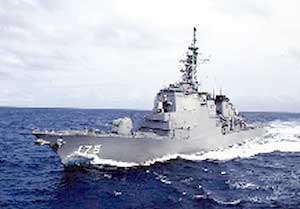| Ueno refused to say when the destroyer
was deployed, and described its mission as part of regular patrol activities.
But the dispatch came as two major Japanese
newspapers reported North Korea appears to be making final preparations
to test-launch its Rodong ballistic missile, possibly around the sea.
The Yomiuri, Japan's largest newspaper,
said U.S. military officials in Japan notified their Japanese counterparts
of the possibility last week after North Korean army vehicles were spotted
gathering near several launching sites in the northeast and other parts
of the isolated communist country.
The Rodong, first tested in 1993, has an
estimated range of up to 940 miles - meaning it could reach most anywhere
in Japan.
In 1998, North Korea launched a long-range
Taepodong ballistic missile over Japan, demonstrating its capability to
reach virtually any Japanese city with warheads.
Regional tensions have been especially
high recently.
On Monday, North Korea test-fired a short-range
missile. It also conducted a test launch on the eve of the inauguration
of South Korea's new president on Feb. 24.
Analysts have said the widely anticipated
upcoming launch from a base on North Korea's east coast fits a recent pattern
of unusual military maneuvers that seem designed to pressure Washington
into dialogue.
In the past weeks, the communist North
has rejected repeated U.S. offers to discuss the nuclear dispute in a multilateral
setting including Russia, China and other countries, and insisted on direct
talks with Washington.
The United States has rejected the North
Korean demand as a ploy to extract more economic concessions.
The South's foreign minister, Yoon, told
South Korea's MBC radio, "North Korea must come out with a more open stance."
Yoon said the eventual solution of the
nuclear crisis would involve economic aid for the impoverished North from
nations besides the United States.
"It's illogical to exclude the potential
aid providers from the talks," Yoon said.
This week's missile test followed a March
4 confrontation between four armed North Korean fighter jets and a U.S.
RC-135S Cobra Ball. No shots were fired in the rare encounter in international
airspace over the Sea of Japan, about 150 miles off North Korea's coast.
The plane flew from a base in southern
Japan.
In Washington, a U.S. official speaking
on condition of anonymity said Wednesday the U.S. Air Force was readying
aircraft to resume reconnaissance flights off the North Korean coast.
Japan ruled Korea as a colony from 1910
until its surrender in 1945 ended World War II. The two countries have
no diplomatic relations, and North Korea frequently has said the presence
of about 50,000 U.S. troops in Japan threatens its national security.

|
